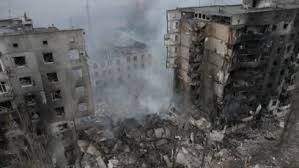On Tuesday, Russia intensified its assaults on cities and towns along a hundreds-of-mile-long front in what both sides hailed as a new phase of the conflict for control of Ukraine’s eastern industrial heartland.
After a failed attempt to take over the capital, Russia declared its main goal to be the takeover of the eastern Donbas area, where Moscow-backed rebels have been fighting Ukrainian forces for the past eight years.
If successful, President Vladimir Putin would gain control of a key chunk of Ukraine and a much-needed win in the now seven-week-old war, which he could show off to the Russian people amid mounting losses and economic misery brought on by Western sanctions.
It would also effectively split Ukraine in half, depriving it of the country’s key industrial assets, such as coal mines, metallurgy plants, and machine-building industries, which are all located in the east.
“The occupiers attempted to break through our defenses along practically the whole frontline,” Ukraine’s military announced early Tuesday, indicating that a “new phase of conflict” had begun the day before. “Another phase of this operation is begun now,” Russian Foreign Minister Sergey Lavrov stated.
Although several analysts noticed that an escalation has been underway for some time, Ukraine’s president said that large numbers of Russian forces were committed to the operation.
Former British tank commander Justin Crump believes the Ukrainian comments could be a tactic to urge allies to send more weapons.
“I think what they’re attempting to do by placing this is… focus people’s minds and energies by saying, ‘Look, the conflict has begun in the Donbas,'” Crump, of strategic advising firm Sibylline, explained. “This puts some pressure on NATO and EU suppliers to say, ‘Guys, we’re going to start fighting immediately.'” ‘We need this right now.’
Arms from Europe and the United States have been crucial in reinforcing Ukraine’s defenses, allowing the country to stave off the Russian assault. The Netherlands will provide “heavier materiel” to Ukraine, including armored vehicles, according to Dutch Prime Minister Mark Rutte, who spoke with Ukrainian President Volodymyr Zelensky by phone on Tuesday.
Russian Defense Ministry spokesman Maj. Gen. Igor Konashenkov said air-launched missiles destroyed 13 Ukrainian troop and weapons locations, while the air force struck 60 other Ukrainian military facilities, including missile warhead storage depots, in what appeared to be an intensification of attacks. Over the previous 24 hours, the Russian fire has hit 1,260 Ukrainian military structures and 1,214 troop concentrations. The assertions could not be verified independently.
The stepped-up campaign, according to Pentagon press secretary John Kirby, is “shaping operations,” laying the groundwork for a larger onslaught in the predominantly Russian-speaking Donbas region.
On that day, the assaults began along a boomerang-shaped front that runs more than 300 miles (480 kilometers) from northeastern Ukraine to the country’s southeast.
Russia claimed missile strikes in Kharkiv, Ukraine’s northeastern metropolis, as well as sites around Zaporizhzhia and Dnipro, west of the Donbas. Gov. Oleh Synyehubov claimed Tuesday that five people were killed in a barrage on Kharkiv.
According to Luhansk Governor Serhiy Haidai, Moscow’s troops gained control of one town in the Donbas on Monday. The defensive line had held elsewhere, according to Oleksiy Danilov, secretary of Ukraine’s National Security Council.
The Russians are one step closer to surrounding Ukrainian troops in the region, thanks to the breakthrough in Kreminna.
The Russians have also moved closer to the city of Slovyansk, whose loss by Russia-backed separatists in 2014 was a humiliating blow for Moscow in the early phases of the separatist fight.
The liberation of Mariupol, a port city in the region that the Russians have besieged since the beginning of the war, is crucial to the battle to seize the east.
Shelling resumed, and Russia issued a new ultimatum to the Ukrainian troops stranded there on Tuesday, promising that any who surrenders will “keep their lives.” Previous such proposals have been turned down by the Ukrainians.
On a messaging app, Ramzan Kadyrov, the Kremlin-backed leader of Chechnya, whose forces have taken part in the combat in Mariupol, warned that Russian forces would root out the Ukrainian opposition within hours and take full control of the steel mill on Tuesday.
Kadyrov, who is notorious for his bravado, has forecast the city’s demise on numerous occasions.
Securing Mariupol would allow Russian soldiers to move further in the Donbas, robbing Ukraine of a strategic port, and completing a land bridge between Russia and the Crimean Peninsula, which Russia has held since 2014.
Russia had begun flying bunker-buster bombs on the Azovstal steel complex where the regiment was holding out, according to Denys Prokopenko, commander of the Azov Regiment of the Ukrainian National Guard, which is guarding the last known Ukrainian pocket of resistance in Mariupol.
The factory, which covers an area of around 11 square kilometers, is also thought to be home to civilians (over 4 square miles).
In a video speech on Monday, Zelensky declared that a “major part of the entire Russian army” is now focused on the Donbas fight.
“We will fight no matter how many Russian troops are sent there,” Zelensky said. “We’ll protect ourselves,” says the narrator.

















